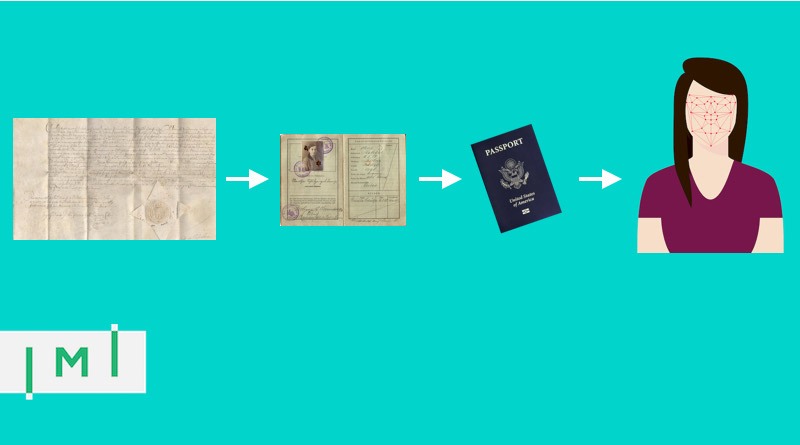The Passport’s Future: Is The Physical Travel Document on Its Way Out?
It has evolved from a piece of paper with a written physical description to a standardised document containing increasingly more information about its holder. The passport has a long and fascinating history. As the move towards further digitisation of identifying documentation occurs, it is interesting to look at its future and technology’s role in its evolution.
Migration towards the further use of electronic passports began in 2005, with more than 150 countries having issued these types of documents by the first half of 2019. Featuring a contactless microprocessor, capable of storing all the identifying data normally found on the data page, e-passports can hold significantly more than a conventional paper passport. Some of these passports – termed biometric passports – also hold digital fingerprints, and other types of unique personal data.
Your face and your fingerprints alone will suffice – eventually
It has been argued that the reliability of electronic or biometric identifying documents is greater than that of the current iteration of passport. By digitising international travel in this way, the efficiency of border control processes is forecast to improve substantially. Taking things a step further, fingerprint, iris, or even facial scanning may also eventually replace current border control methods. Rather than presenting a physical passport, travellers will soon routinely be able to enter a country by having their biometric data scanned. This data will then be linked to a remote server, containing the necessary information on the individual at hand.
In 2015 the World Economic Forum introduced The Known Traveller Digital Identity, or KTDI, initiative. By January 2018, the governments of Canada and the Netherlands reached an agreement allowing people to travel document-free between the two countries, presenting only their smartphone. The aim of this initiative was to speed up the flow of passengers passing through airports, while reducing the risk of identity fraud. The mobile interface created for these purposes allows travellers to “carry their digital identity with them and choose who to share it with”.
Trials of this project ran throughout 2019. Prior to reaching the airport, travellers’ information would have already reached the relevant airline and border authorities. Individual consent is required every time, thus giving passengers better control over their personal information. A series of measures were also in place to ensure the protection of data: cryptography created an additional level of security in the authorisation and distribution of information, and the data itself was stored on a distributed ledger, rather than in one central database.
Smartphones as passports
Other countries have also undertaken similar initiatives in attempts to find solutions for more efficient and secure traveller identification. For example, Dubai allows residents and nationals to use their smartphones as passports, by downloading an app called ‘Smart UAE Wallet’. Australia has also allocated a 90 million dollar budget over a five-year period, for its ‘Seamless Traveller’ programme. Through a law passed in 2015, the Australian government gained authorisation to collect more biometric data from its citizens and other international travellers at its airports. The idea is to be able to identify travellers without the need for human interaction. Eventually, the plan is to have enough biometric data linked to personal information stored on the cloud to make this a feasible travel option.
Japan, on the other hand, introduced a scheme last year wherein short-term travellers are now able to skip queues when leaving the country through the use of facial recognition technology. As explained by an official at the Immigration Services Agency, Japanese authorities “hope the automization of embarkation procedures will help ease customs procedures and will allow more immigration staff to be tasked with other duties.”
Despite the number of initiatives spearheading the move away from physical documents and towards biometric scanning, it will still be difficult for the physical passport to be totally replaced. Aside from the significant financial investment associated with the full digitalisation of identity verification, reaching agreements between different states will also be a problem. The creation of a single standard, to be adopted by the international community as a whole contradicts the current world structure, wherein separate countries are vying for their own self-protection and interests. And it is for this reason that physical documents, albeit with more distinct electronic features, seem to be here to stay for the foreseeable future.
Beyond biometric data
In light of this, and especially in the context of the COVID-19 pandemic, which brought international travel to a standstill earlier this year, it is not difficult to think of e-passports holding medical records, insurance policies, and other similar information in the near future. In countries like China and Singapore, amongst others, citizens are already required to download an app verifying that they are virus-free prior to being allowed entry into establishments and on public transportation. In Chile, a virus-free certificate is also given to recovered citizens, thus relieving them of most restrictions.
Looking forward, e-passports may also serve as sort of ‘immunity passports’, which, as explained by Huasyn Kassai, co-founder and CEO of Onfido, a British tech-company, are “designed to help an individual prove that they have been tested and that their result belongs to them, but without having to share any personal information.” The successful realisation of such a concept, however, still depends on a good number of countries coming together and agreeing to its implementation.
Concerns have also been voiced about the extent to which citizens are comfortable providing governments with this amount of data, especially keeping in mind that the more of this kind of information governments hold, the likelier they are to turn to data mining. Although this does have its merits in that it helps identify possible security threats, opponents stress the potential for surveillance this brings with it.
In response to such concerns, blockchain technology has been hailed as a significant stakeholder in the future of the electronic passport. A blockchain-based-data-sharing system may provide some comfort by removing the need for a centralised database. In an article published in 2018, Mandar G. Chaphalkar, Senior Technology Architect at Infosys explains that “due to its extremely secure nature and its intrinsic ability of deference to extremely deep and complex checks, it’s the ideal application for decentralised travel authorisation.”
The next generation of e-passports is, therefore, likely to be considered a ‘smart object’, as we move towards such documents becoming faster, securer, and more advanced thanks to a combination of different technologies. The further integration of electronic passports with smartphone apps also seems likely, according to Thales Group – an aerospace company – allowing travellers to be able to verify their identities in a more efficient manner.
Nicola graduated with a first-class honours Bachelors of Arts degree in International Relations at the University of Malta. She was President of JEF Malta whilst at University. She joined Frendo Advisory immediately after graduation, and has experience in the Individual Investor Programme, and the Global Residence Programme.



